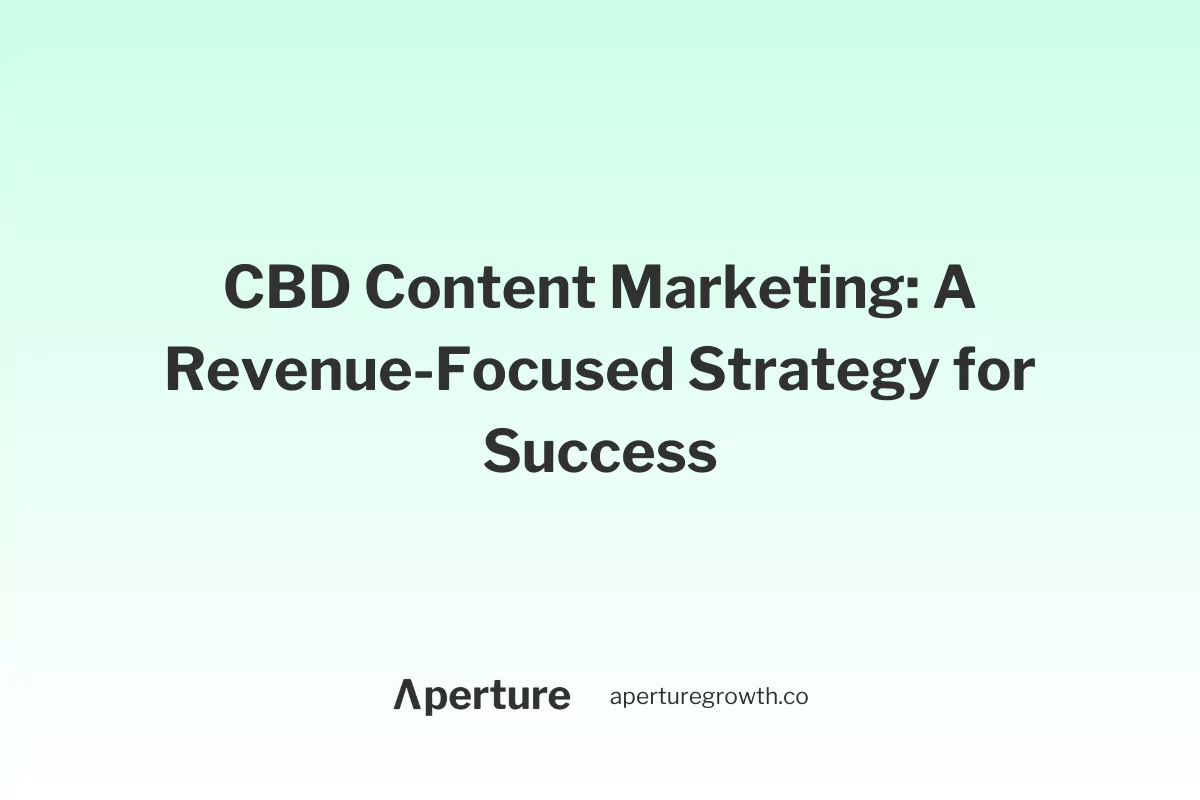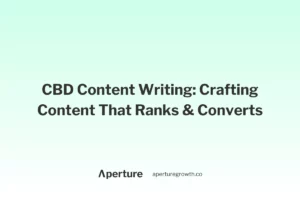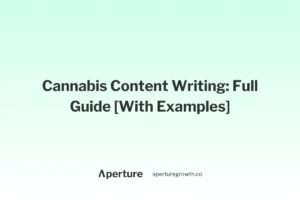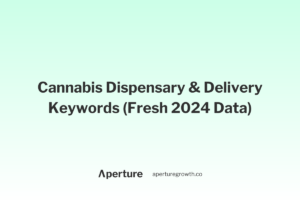If your CBD brand is just starting its foray into content marketing, you’re probably a little overwhelmed.
There are seemingly endless channels you can use — SEO, email, all the social media platforms, to name a few. And you likely don’t have the time or budget required to do them all. At least not well.
So you’re probably trying to decide which few you should focus on so that you can invest in marketing that gets results without spreading yourself too thin.
The good news is that with a well-thought-out CBD content marketing strategy, the right content channels for your brand will become obvious. And no, you won’t have to do them all. You might even get away with focusing on just one or two core channels.
So how do you go about building your strategy and choosing where to focus?
For the next little while, we’re going to discuss everything you need to know about building a CBD content marketing strategy, including compliance, finding your target audience, choosing content marketing channels, and other topics.
Let’s get into it!
Why Should Your CBD Brand Leverage Content Marketing?
Since you’re researching CBD content marketing, you probably already have some idea of why it’s important for your brand.
Nonetheless, it’s worth fully understanding why content is such a beneficial option for your CBD Brand as compared to — or as a complement to — paid ads and other similar methods.
Knowing the benefits of content marketing, when it’s done right, helps you to better use it.
Content marketing drives revenue
The most obvious reason CBD brands should invest in content marketing is that it drives revenue.
If two companies are doing the exact same thing, but one is investing in high-quality content marketing and the other isn’t, the company that is investing will make more money.
Content marketing has become the dominant digital marketing strategy because the internet is, fundamentally, information-based. Companies that can positively influence this ecosystem and gradually introduce people to their products are at an advantage.
Depending on the type of content, revenue may be easy or hard to attribute. And some forms of content aren’t designed to drive direct sales, but to build awareness.
But to give you an idea of the impact content can have, consider this: we routinely see CBD brands, including some that we work with, driving a majority of their e-commerce revenue from their content marketing efforts – and they invest just a fraction of what they make.
Content marketing builds a moat of trust & that paid marketing can’t
The CBD industry isn’t regulated by the FDA, and (you know this) it’s rife with poor-quality products. As a result, many people have a hard time trusting CBD companies. How do they know your products really are high-quality?
If people trust a company, they have no problem giving them their money in exchange for products, because they know what you’re giving them in return is safe and effective.
If you have a good product to offer, then, showcasing your brand’s quality and reliability are key to building trust with customers. Content marketing is the best way to do this.
Unlike paid marketing, content marketing sells by educating, answering questions, and building context.
Paid marketing just hopes this context has already been built. It’s often successful, but only after prospective customers have already come into contact with your brand and its content.
Anybody can run paid ads if they have money, but brands can only create quality content if their brand has something worth saying. If your CBD brand has something unique to offer, content marketing is how you differentiate yourself from the others and win loyal customers.
Content marketing offers an alternative to paid ads
In addition to having a few innate advantages over paid ads — that are amplified in low trust industries like the CBD industry — content marketing gives CBD brands a way to acquire customers that doesn’t involve using an ad platform.
Normally, “content marketing exists” isn’t a good reason to pass up paid ads, but advertising in the CBD industry is heavily restricted.
Platforms like Facebook only companies to market CBD products in very specific ways, and even at that, only if they’re spending a certain amount.
In short, paid ads are off-limits for many smaller CBD brands. And if they are an option, they’re only highly effective if the brand is running retargeting ads on past website visitors. And the best way to get website visitors? Content marketing.
Content marketing improves retention
If you want your CBD brand to grow, retention is just as important as acquisition. The first challenge is over – they bought your product. Now the second challenge begins: keeping them from forgetting about your brand.
With a dialed-in content strategy, retention gets easy.
By continuously creating compelling content and putting it in front of your customers, your brand stays relevant in their world.
When it’s time for them to buy more CBD, they’ll be more likely to go with your brand, because you’ve been a (tiny) part of their life for the duration since their last purchase.
People don’t like the unknown. They want to go with the familiar. Your brand can be familiar to people if you’re producing content – in addition to products – that is worth caring about.
Compliance: What You Can and Can’t Say When Marketing CBD
Maintaining compliance is a must for any CBD marketing strategy, but especially so for content marketing, where you’ll be producing lots of written and video content.
Before you produce a single piece of content, you’ll want to make sure you understand what your CBD brand can and cannot legally say about its products.
There are two compliance-related things you’ll want to account for:
Avoid medical claims
On the compliance side of things, the most important thing your CBD brand can do is avoid making medical claims about your products.
Essentially, you cannot say that your product cures any medical condition or improves a state of poor health.
What you can do is say your product supports normal health states. To make this more concrete, let’s look an example:
COMPLIANT COPY: Our CBD Oil promotes relaxed, healthy joints.
NON-COMPLIANT COPY: Our CBD Oil relieves joint pain caused by tendonitis.
Do you see it? In the first example, we’re saying that our product helps the body remain in a normal, healthy, relaxed state.
In the second example, we’re implying that our product can greatly improve the body’s decificient state — a case in which the joints are aching and discomfort pervades.
Make sure you embrace this style of writing throughout your copy, be it in your product pages, blog posts, or social media graphics.
Don’t say anything that suggests your product solves illnesses, conditions, or other negative health states. Instead, say that your products support good health.
One method you can use to discuss the potential benefits of CBD and other cannabinoids – not your product specifically, but in general – is to talk about the research that’s been done.
However, it’s important that you don’t use research to make medical claims about your product, and that you don’t, in any way, misrepresent the conclusions of various studies.
For instance, if the scientists conclude that more research is needed before we know whether CBD is safe, you also need to mention this so that you don’t mislead people into believing that scientists are giving their unabashed approval of CBD when they’re really not.
The Supplement Disclaimer
The other thing you’ll want to make sure you do is include the supplement disclaimer.
CBD products are considered supplements by the FDA.
As a result, you must display this disclaimer text on every page of your website:
- These statements have not been evaluated by the Food & Drug Administration. This (or these) product(s) are not intended to diagnose, treat, cure, or prevent any disease.
1. Determine Your CBD Brand’s Target Audience, Messaging Style, and Content Marketing Goals
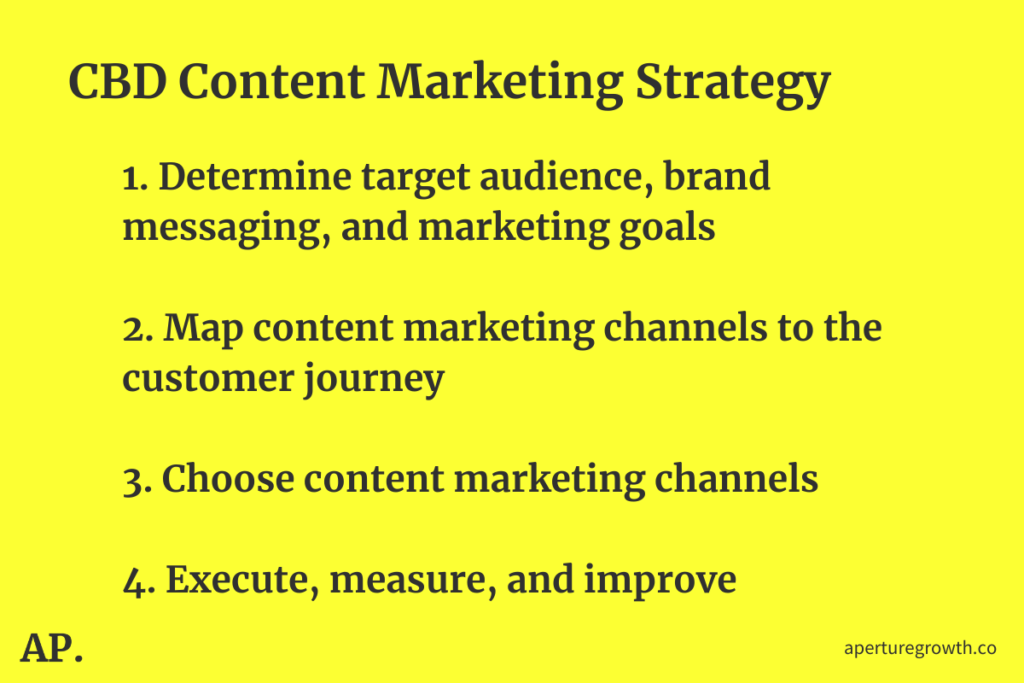
With the legal technicalities out of the way, it’s time to get into building your strategy.
But before you produce a single piece of content, you need to understand your audience, your brand messaging, and your content marketing goals.
This fits into the what, how, why framework:
- Knowing who you’re speaking to allows you to determine what to say.
- Knowing your brand’s unique messaging – your tone and voice – allows you to determine how to say it.
- And finally, knowing your content marketing goals (business and otherwise) helps you know why you’re saying it.
Establish your audience (what to say)
Unless you know exactly who you’re creating products for, you’ll never be able to create content that resonates with or is useful to them.
Finding your audience
Depending on how established your brand is, you probably already know who your audience is. But if you don’t, simply ask yourself what problems your products solve, and who they solve them for.
Some examples:
- Your products solve the pain point of joint pain for elderly people
- Your products solve the pain point of menopausal pain for middle-aged women
- Your products solve the pain point of not enough vegan CBD products on the market for vegans
If you already have paying customers, especially if you have a brick-and-mortar store, the following questions can further illuminate things:
- Which customers find your products most helpful (who gives the most positive feedback)?
- Which customers spend the most money, the most often, with your business?
The more specific your audience is, the better — to further refine, think about the age and interests of your average customer.
Still, even if all you do is are exercises above, you’re off to a really good start.
Over time, you may realize you’re attracting a slightly different audience than you initially intended. This is okay, just understand why this is the case and what you can do to reach them even better.
Determining what to talk about
With your audience in mind, the hard part is over — you have insight into the topics you should discuss in your content.
If the pain point you solve, for example, is post-workout soreness, then focus your content on topics around recovery and workouts where it makes sense to tie your product in.
Remember, too, that the CBD content ideation process will look different for each channel. Although your core message will be the same everywhere, some marketing channels may have existing demand that you can tap into and funnel toward your product (e.g. SEO), while others won’t have obvious demand and will require you to do a bit of guesswork or observe competitors (e.g. social media).
Establish your brand messaging (how to say it)
Now that you know what to say and who to say it to, it’s time to figure out how to say it to them.
To figure this out, you’ll need to establish your brand’s voice and tone:
- Voice: Your company’s unique perspective and values. This has less to do with your choice of words than it does with the angle from which you approach the topics you discuss.
- Example: Your company cares deeply about helping people reduce their reliance on Big Pharma, so you often discuss your products in the context of helping people find a natural alternative to prescriptions.
- Tone: Your company’s attitude and the way you speak.
- Example: Your company makes products for U.S. Veterans, so you take a very direct and straightforward tone that resonates with former service members.
Remember, marketing is emotional. People trust you when they feel like you can feel them and relate to their struggles.
If you’re serious about your CBD business, it’s probably because you really care about helping people — developing an authentic voice and tone, then, shouldn’t be insanely difficult. It’s just a matter of giving it some thought and being consistent.
Establish your goals (why you’re saying it)
For most businesses, the goal of content marketing is more revenue.
But you should consider the goals of your content efforts on a more granular level, as they’ll help inform the types of efforts you make, as well as how you measure success.
We’ll discuss metrics and KPIs when we cover the various content marketing channels. Here, we’re more focused on how your goals determine what you discuss and where.
For example, if your goal is to retain more customers through content marketing (which increases revenue), then your micro-level goals might be to teach your customers the benefits of an ongoing CBD routine, as well as to build a relationship with your customers that makes them want to stay with your brand versus going somewhere else.
Forming these sorts of micro-goals makes the ideal content strategy all the more obvious: now you know what to talk about.
Based on this, you can choose what channels would be the best fit for your content.
Going with the retention marketing example, email and social media would be effective options, as they allow you to stay in touch with customers who are following you or have signed up for your emails.
On the customer acquisition end, you’ll probably be focused more on answering questions and educating people about how CBD can help them achieve their wellness goals.
In this case, you’d be best suited to focus on SEO, which allows you to show up when people are searching various things on Google or other search engines.
Whether or not you have specific numeric sales targets you’re trying to hit, you want to have a rough idea of the main goals your CBD brand wants to achieve with content marketing. This will dictate the types of content you create and where you distribute it.
Step 2: Map Your Content to the Customer Journey
With your content marketing foundation down, you’re almost ready to choose channels. But there’s one more thing you need to do: examine the marketing funnel.
If you understand what you need to say and to whom (the previous step) AND you understand how different channels function from a pragmatic standpoint, you’ll be able to zero in on exactly where to invest your time and money.
The marketing funnel (also called the buying funnel or just “the funnel”) is essentially a visualization of how customers purchase products. It includes the stages they go through, from initially learning about your products to deciding to buy one of them.
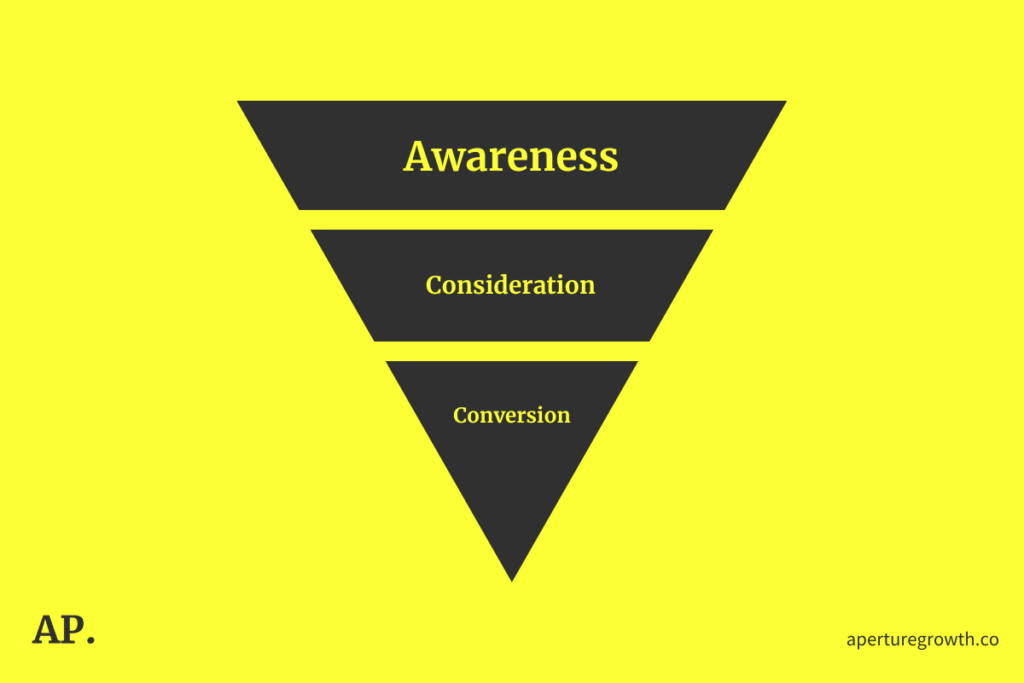
Depending on who you talk to, there are three, four, or more stages to the funnel. For simplicity, we use the three-stage model:
- Awareness – Your potential customer learns that your product category (in this case, CBD products) exist
- Consideration – Your potential customer learns about how your product category can help with a problem they have, and they begin considering whether they should purchase a product in your category
- Conversion – Your potential customer makes the decision to buy a product in your category, and begins to research specific options with the intention to buy
Every person who buys CBD goes through some version of this customer journey. Your goal as a company is to get your products in front of people in the Conversion stage.
From a revenue standpoint, all customer journeys will fall into two buckets – either they do buy from you, or they don’t.
But from a marketing standpoint, understand that there’s a difference between (a) introducing someone to CBD, and then, through careful marketing, gradually nudging them toward buying one of your products and (b) swooping in and getting them to buy one of your products after they’ve already gone through the first one or two stage(s) of the funnel.
The reason this differentiation is important is because you’ll want to design content marketing efforts that effectively convert people in either scenario.
This means you won’t just focus on bottom-of-funnel tactics and ignore building a brand or building product awareness, but it also means that you sure as hell won’t gloss over easy marketing opportunities to convert already-interested prospects.
Step 3: Choose & Execute CBD Content Marketing Strategies
With the marketing funnel in mind, let’s discuss the various CBD content marketing strategies that exist. This isn’t an exhaustive overview, just the most important channels. We’ve excluded channels that:
- Don’t make sense unless your CBD brand is very large already (e.g. affiliate marketing partnerships and paid ads)
- Aren’t channels, but are tactics commonly miscategorized as channels (e.g. video marketing)
Additionally, because we believe that strategy comes before tactics, we aren’t going extremely in-depth on the specific actions you need to take in each channel – these topics deserve their own articles, as learning how to use a channel is much different than learning how to choose channels (and why you’re choosing these channels).
Besides, the difficulty is rarely know where to start with a channel – the hangup comes when deciding which channels to invest in and how much.
For each channel, we cover five areas:
- Purpose – The basic role the channel plays in acquiring customers.
- How It Works – The channel’s specific role(s) in acquiring customers; how it moves people through the funnel.
- How to Measure Success – The metrics and methods you should use to measure how well the channel is working.
Websites for CBD Brands
If you’re selling CBD – or pretty much anything – online, having a website is a bare minimum for doing business.
Nonetheless, your website is a marketing channel (and it’s the basis for SEO, another marketing channel).
Your website provides the basic functions you need to sell online – a place to list your product offerings, a way to accept payments, and the provision of a way for your customers to contact you.
But it also functions as a marketing tool.
Having a website opens up lots of marketing possibilities that otherwise don’t exist. Email marketing is a lot harder without a site, and gaining any visibility in organic searches (via SEO) is impossible.
Simply put, if you’re going to sell CBD online, a website is a must-have.
How It Works
Your website serves as the “home base” for all of your content marketing efforts, and prospective customers in every stage of the marketing funnel will interact with it.
Your website can reach customers in the top of the funnel (Awareness stage) (through SEO), guide people through the middle of the funnel (Consideration stage) (through SEO and non-search-focused content), and, finally, be the place people in the bottom of the funnel (Conversion stage) go to buy products.
To make this more concrete, let’s look at some examples.
Some forms of marketing, like SEO and SEO-focused blogging, are an extension of your website. SEO is versatile; it can reach people in any stage of the funnel.
Other types of content marketing aren’t website-based, but they have a symbiotic relationship with your site.
Email, for example, relies on your site to capture email addresses from visitors. Later, your emails will (hopefully) send people back to your site to purchase products. People will go between your site and your emails as they move down the funnel.
Social media might send people back to specific pages on your site – contests you’re running, pages about influencers who are representing your brand, and educational articles you’ve written – as they move down the funnel (or move toward a second purchase after they’re already a customer).
Your site is your CBD brand’s digital home. It only makes sense, then, that it’s relevant to every stage of the funnel.
How to Measure Success
A successful website is a vague goal, because your website has lots of functions.
However, the most critical function of your website is to give people a place to buy your products. Since the purpose of all your marketing is to get people to buy your products, the most important metric for your website is conversion rate.
It might seem silly to ignore traffic, but traffic is more a reflection of your SEO and other efforts than it is an indication of your website’s quality from a user experience and brand affinity perspective.
To determine your conversion rate, you’ll need to look at the amount of traffic a certain page (or form, if you’re measuring email signup conversion rate) is receiving versus the number of conversions it generates.
There are ways to view this metric in Google Analytics. You can also simply calculate what percentage of sessions (users) on a page end up converting.
Simply put, the higher a specific page’s conversion rate is, the better of a job it’s doing at helping users complete the action you want them to take.
SEO & Blogging for CBD Brands
Search engine optimization (SEO) offers a powerful alternative to paid ads, which are off-limits for many CBD brands due to restrictions and budgets.
One compelling reason for your CBD brand to invest in SEO is that many brands aren’t: in study we did of where the top CBD companies get their traffic, we found that 70% of the largest CBD companies rely primarily on branded search terms for the majority of their traffic.
How It Works
SEO is a set of practices for optimizing your website to increase your vibility in search engines. It involves improving existing pages and creating new ones, with the goal being to rank for terms that your prospective customers are searching for.
By building and executing a CBD SEO strategy, your brand can directly increase revenue, as well as kick-start other marketing channels.
Let’s flip the funnel on its head and discuss the benefits of SEO from the bottom of the funnel up.
At the bottom of the funnel, optimizing your product category and individual product pages enables you to rank higher for search terms that are indicative of buying intent (i.e. people looking for a group of products or a specific product)
Ranking for bottom-of-funnel search terms can directly increase your revenue by making your business more visible to people who are ready and want to buy products like yours.
Moving to the middle of the funnel, creating SEO-focused blog content can help your brand show up for terms that indicate a person knows about CBD and related products, and is exploring the ways that these products could help with their conditions.
Ranking for middle-of-funnel search terms will drive some direct revenue (though not as much as from bottom-funnel terms). This type of SEO is also very effective at capturing email addresses from visitors, who can then be nudged down the funnel toward a purchase using email marketing.
At the top of the funnel, SEO-focused blog content can rank for search terms that indicate a person is trying to learn more about CBD and hemp. They might be searching things like, “does CBD make you high?” or “is CBD legal in [your state here]?”
Ranking for top-of-funnel search terms can help with email capture, although people who sign up from articles that are higher in the funnel won’t typically convert as often or as quickly as those who sign up from article that rank for search terms indicative of a present interested in CBD products.
Because SEO is about meeting demand that already exists, with the right CBD keyword research strategy, you can use this channel to reach customers at every stage of the funnel.
How to Measure Success
As with your website, there are lots of different metrics that are worth measuring for SEO – as we discussed, you can use SEO to do everything from build awareness to capture sales from people who are ready to buy.
However, as with your site, there is one metric that trumps them all: organic revenue. Organic revenue is revenue from users who found you through organic search. The higher your organic revenue is, the better your SEO is working.
Just be sure to measure individual parts of your SEO strategy with more relevant metrics. For example, the performance of your top-of-the-funnel blog posts, which are designed to expose your brand to as many readers as possible, should be measured in email signups, rather than revenue.
Email for CBD Brands
Email marketing allows your brand to appear in a place that’s near and dear to your customer: their inbox.
In our view, email is non-negotiable for CBD brands – for many brands, email helps drive anywhere from 20% to up to 50% of all revenue.
If you have an email list, you must invest in email marketing, if you don’t, you need to build one (in the short term, through referrals, social media, etc – long term, you’ll want to invest in a sustainable growth engine, such as SEO) and begin sending emails to it.
How It Works
Email is a form of direct-response marketing, the goal of which is to elicit an instantaneous action from the recipient.
Whereas blogging and social media helps you “court” your potential customer – educating them, answering their questions, and clearing up uncertainties – email inspires them to act once they already trust your brand.
While email can convert new customers, though, it’s more effective at driving repeat purchases from existing customers. That’s why it’s such a critical channel: it helps your business grow, because you’ll make consistent revenue from your current customers while your acquisition channels (e.g. SEO) bring in new customers.
Like most channels, email has a variety of specific functions.
In the top of the funnel, sending educational content and talking about your company and how it helps people serves to slowly build rapport with the people on your email list.
Once they’re familiar with your company and with CBD products, you can begin discussing your products in more detail, outlining the specific benefits they have for your customers.
And once someone is ready to buy, sending them emails asking them to check out specific products (again, from a value-first angle), along with the occasional discount or deal, can be very, very effective at driving purchases.
However, your strategy shouldn’t be based around individual campaigns, but around email flows, which are automated sequences of emails sent to subscribers when certain conditions are met.
When fully optimized, flows enable you to automatically send messaging that you know is provent to prompt an action. Different flows are sent to different people based on the next logical step they should take.
If the person hasn’t purchased and is a new subscriber, then a welcome email flow can be sent. It might include a discount code, an introduction to your company, and testimonials and reviews from customers.
If someone adds products to their cart but doesn’t checkout, an abandoned cart flow can be sent. This will contain messaging designed to nudge the prospective customer to complete their purchase.
The possibilities are endless with flows, as with campaign. You’ll need both in order to maximize the ROI of your email list.
However, in order to know who send what emails to, you’ll need to segment the people on your list based on their source (e.g. they signed up from the main email form; they came from organic search), behaviors (e.g. did they abandon their cart?), and other attributes.
Although most email tools make building your segments relatively easy, you’ll need to employ funnel thinking in order to decide which segments to create and what to send to each.
By fully leveraging individual campaigns, flows, and segmentation, you can generate loads of new and repeat revenue.
How to Measure Success
As with many channels, revenue is the main metric you should be concerned with when it comes to measuring your email marketing efforts. Because different campaigns and flows have different goals, you’ll need to use specific metrics to measure the success of each.
And there are multiple metrics that may be worth measuring for each type of email.
Generally, open rate (percentage of people who view your email) and click rate (percentage of people who click on the link(s) in your email) are important metrics for every email. They measure how well of a job the headline and content of your email are doing at convincing people to act.
For promotion-focused campaigns (i.e. those that include links to your products and exist to drive sales), revenue is the north-star metric.
Social Media for CBD Brands
Organic social media marketing on platforms like Instagram, Facebook, TikTok, and Twitter can help your CBD brand build trust and affinity with current and potential customers.
Social media gives your brand a way to have a conversation with your customers.
If someone walks into your brick-and-mortar store or runs across your booth at a convention or farmer’s market, coming across as likeable and trustworthy is important for building a positive reputation and gaining new customers. The same rules apply on social media.
How It Works
Organic social media generally is not effective at acquiring new customers for two main reasons:
- People typically don’t have a reason or desire to follow your social media profiles before they’ve made a purchase
- Reaching people who aren’t following you on social media is very difficult (this is a relatively new phenomenon) unless you pay for ads (which, as discussed, are off-limits for most CBD brands)
Where social media shines is in nurturing and building relationships with customers who already follow you. This can then, indirectly, increase repeat purchases.
There are many ways to build these relationships and have these conversations.
Your brand’s social media can serve as a place to make announcements about specials, new products, and more, as well as a “billboard” to showcase your products with beautiful images and videos.
The trick is to talk to your customers, rather than at them. In addition to using direct language and speaking as if you were talking to a specific person, you’ll want to make community-oriented posts – run surveys, ask questions, and post funny stuff.
Overall, treat social media for what it is – a place to get social with your customers. Announcements and product promotions are helpful, but make the focus on engaging with real people and bringing bits of joy and intrigue into their day (and social feed).
How to Measure Success
There are several types of metrics you’ll want to measure for social media – both on- and off-platform.
Generally speaking, measuring your follower counts and post reach month-over-month can help see whether your audience is growing, shrinking, or staying stagnant.
Measuring metrics like engagements (likes, comments, etc.) and engagement rate helps you see which posts are connecting with people.
If a specific post is designed to drive off-platform action, such as landing page views, email signups, and sales, you’ll want to measure these specific metrics by using UTM codes.
Influencer Marketing for CBD Brands
The final CBD content marketing strategy that we’re going to discuss is influencer marketing. It’s really a sub-strategy of social media, but it requires such a different approach that we consider it a unique strategy.
How It Works
Influencer marketing is when your CBD brand partners with relevant influencers – people who have online audiences who’d be interested in your product.
You offer an influencer some sort of compensation (free product, a sum of money, etc.), and in exchange, they promote your product on their social media profiles. Influencer marketing for CBD and other e-commerce brands is most common on Instagram and TikTok, but it’s also present on X (formerly Twitter) and other platforms.
Influencer marketing is all about aligning your CBD brand with influencers who have similar values – and who have an audience that might be interested in your company and products. It can be thought of as marketing your brand to influencers – if they resonate with your company, it’s likely their audience will, too.
Like other types of social media marketing, influencer marketing is less about selling or funneling people toward a purchase and more about building a community behind your brand that’s based on shared values and interests.
How to Measure Success
Ultimately, the success of an influencer partnership is the amount of revenue they drive for your brand (usually tracked through an affiliate link(s) or a coupon code).
However, don’t focus on cold, hard cash in the early days – look for the more human signals. How do the influencer’s followers regard your brand? Are some of them following your brand’s profiles or interacting with your posts?
Building relationships is a long-term marketing strategy, and this is especially true for influencer marketing.
Step 3.1: Use CBD Content Marketing Micro-Tactics
A CBD content marketing channel is executed through channels, so it’s important to think in terms of channels when deciding where to use your resources (time, money, etc.).
However, there are a few foundational tactics that should be a part of any content marketing effort you undertake — many of them rooted in human psychology — that create a lot of leverage.
The results they can get for your business far outweigh the work they take to implement. Let’s cover them.
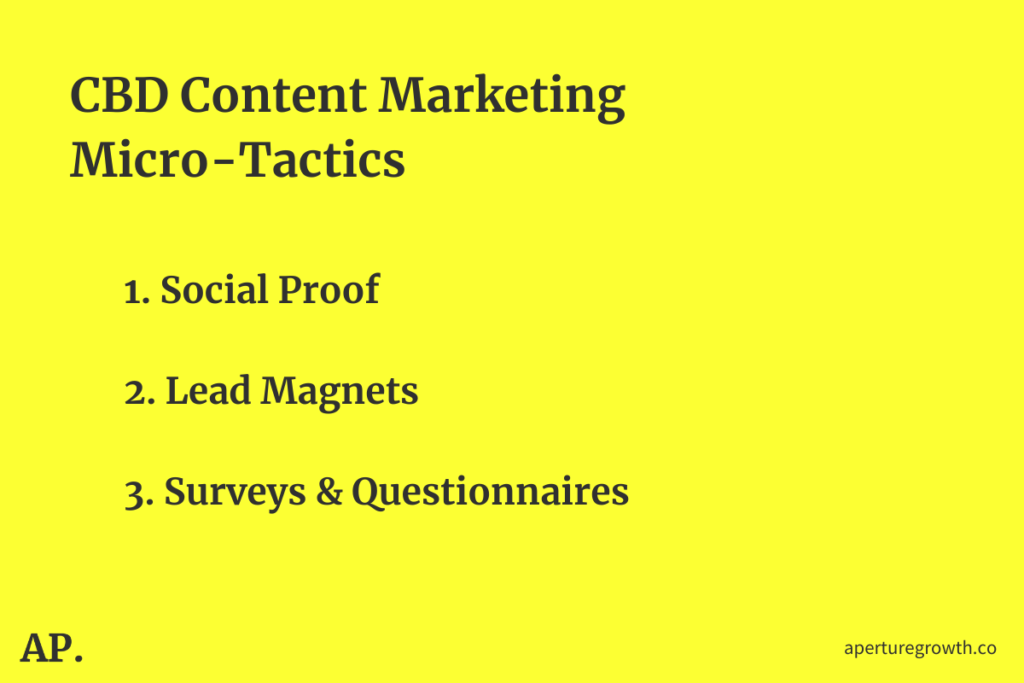
Social Proof
People are mimetic; they naturally imitate each other and use each other as points of reference when making decisions.
And therein lies the power of social proof. When done correctly, using social proof in your content can do two things:
- Show prospective customers that other people like your products. This assures people that others find the experience your product gives to be favorable.
- Show prospective customers that your products really work, because other people are seeing good results with them. This removes doubt in the mind of the buyer and helps them build confidence in the purchasing decision they’re contemplating.
In terms of metrics, social proof has been proven to increase conversion rate.
As with many of the topics we touch on this in article, using social proof in content marketing deserves an article of its own.
Nonetheless, here are a few ideas for using social proof in content that we’ve seen work well:
- Include reviews on product pages (this is a huge conversion booster)
- Include video testimonials and/or reviews on your website homepage
- Include video testimonials and/or reviews in your emails, especially your email flows
- Share testimonials and reviews on social media
Overall, the goal of social proof is to show that your brand is well-loved and your products are highly effective.
Lead Magnets
A lead magnet is a free resource that you give potential customers in exchange for their email address. Lead magnets are a powerful tactic because they can help you build your email list while providing value to your customers (which is always a good idea).
Lead magnets are also versatile because they can work in a variety of contexts. You can create a pop-up form or a landing page to facilitate the email-value exchange, and you can promote them on social media, in your emails, or on your blog posts.
To brainstorm potential lead magnet ideas, ask yourself some questions about who your potential customers are and what they might be interested in learning about.
A particularly powerful question to ask is, “what piece of information often creates an aha moment for my customers, or instantly changes their mind about the value of my products?”
In the CBD industry, it could be referencing specific research that’s been done or discussing how to choose the best product in-depth.
Look for turning points, then make this them into a resource that people want badly enough to give you their email address.
Surveys & Questionnaires
Running surveys and questionnaires has two distinct benefits: it helps you learn more about what your customers want, product-wise, and it helps you learn your customers’ concerns — it gives your buyer a voice.
Use email marketing, social media, and online survey platforms to build and distribute your survey. You can even just send an email asking your customers to reply with their thoughts.
Ideas for what to ask include:
- How satisfied customers are with various aspects of your product experience on a scale of 1/10. For example, if you sell CBD oil, you could ask them to rate your checkout, shipping, packaging, the taste of the oil, how effective it was, and more.
- What products customers would like to see in the future
- What could be changed about current products
- How customers heard about your products
- Whether your customer would recommend your products to a friend or family member
Don’t just focus your survey on improving your product; be sure to run surveys that ask customers about their thoughts, feelings, and experiences as they pertain to your industry. This is how you get better, more useful responses, and higher participation rates. For further inspiration, see these examples.
Step 4: Continuously Improve Via the CBD Content Marketing Feedback Loop
As we discussed in the introduction to this article, your CBD brand can’t reasonably execute successfully in every single content marketing channel – at least not without hiring employees or an agency.
That’s why it’s critical to choose the right content marketing channels. But it’s not just the initial choices that need to be nailed down — you have to know when to keep pursuing a channel and when to try another.
To help you assess your content marketing performance and decide whether to double down on a channel or scrap it and try something else, use this simple framework:
- If a channel is delivering a positive ROI, invest more resources into it than you have been. Preferably, you’ll invest orders of magnitude more than you have been. You’ve found a winner.
- If a channel is not delivering a positive ROI, ask yourself these questions, and take the related actions:
- Have I been investing in this channel for long enough to reasonably see results (usually 2-3 months of consistent investment; for SEO, maybe 4-6)? If not, keep using the channel for the duration (which varies) before assessing results.
- Are my marketing efforts in this channel on or above the level of my most successful competitors? If not, you’ll want to improve your work in that channel (e.g. improve the quality and frequency of your blog posts, improve the way your social media looks, etc.) and work at it for the time in which you can reasonably expect some results before re-assessing.
- Have I put in the time and effort typically required to make this channel successful? If you have, and it’s still not working, it’s probably worth exploring another channel.
- Would dropping this channel allow me to focus on a channel that is already delivering an ROI but could be doing even better if I invest more resources in it? If yes, drop the failing channel and double down on what’s working. You can always revisit the channel later; for now, maintain and increase the momentum you have elsewhere.
Metrics (hard measures of a channel’s performance) and benchmarks (what your competition is doing) can help you assess whether you should abandon a channel or stay the course.
But you should also use your gut — if a channel feels like the right place to reach your customers, keep at it. If it doesn’t, it’s worth understanding why it isn’t a fit and deciding what to do based on that information.
Conclusion: How to Use Content to Acquire More Customers for Your CBD Brand
If you’re a CBD brand owner who has no idea where to start with your content marketing, we hope this article has been helpful to you.
Ultimately, success with content marketing comes down to getting started.
Once you start creating content and sending it out into the world, you can assess what is and isn’t working, and begin refining what channels to focus on, and what to focus on within those channels.
You won’t be afforded this privilege if you spend all your time in the planning phase without shipping any significant work.
Just be sure to put strategy before tactics, and make calendars and roadmaps to keep yourself consistent with creating your content and auditing your efforts. In content marketing, consistency is what pays off.
I hope you found our article valuable. Questions, comments, complaints, concerns? Leave a comment below, send me an email: (wells [at] aperture [dot] co), or find me on X .

